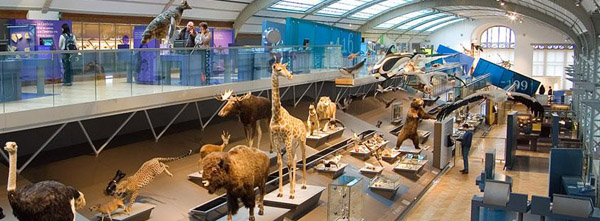
Meet the famous Bernissart Iguanodons in the largest Dinosaur Gallery in Europe. Learn about the human body and how it evolved in the Gallery of Humankind and go back in time in the Gallery of Evolution. You can also find out about urban species in BiodiverCITY, discover specimens which illustrate the Museum’s history in the 250 years of Natural Sciences hall. Admire the magnificent crystals in the Mineral Hall, and experience something new every year by visiting the temporary exhibitions or by taking part in one of the educational service’s interactive activities.
The Royal Belgian Institute of Natural Sciences is involved in important scientific research activities and carries out public service missions. It is open to everyone through the Museum of Natural Sciences.
Scientific Research into Natural Sciences
One in three people at the KBIN-IRSNB is a scientist. The scientific personnel includes mainly biologists, palaeontologists and geologists, but also oceanographers, anthropologists and archaeologists, as well as geographers, physicists, bioengineers and mathematicians, which enables us to conduct multidisciplinary research. The research is focussed on the following areas:
Scientific Expertise Aiding Public Authorities
The KBIN-IRSNB provides scientific expertise under Belgium’s international commitments in relation to environmental protection. It develops tools and methods for monitoring natural land or marine environments. It also offers useful advice for the development of national and European policies for the protection and conservation of biotopes and biodiversity.
Conservation and Management of Scientific and Heritage Collections
With 37 million specimens conserved as Belgian heritage of universal significance, the KBIN-IRSNB’s collections serve above all as reference and research tools. Just behind London and Paris in European classification, the collections in Brussels have been awarded the European label of ‘major research infrastructure’ and in this respect are constantly being visited and studied by researchers from around the world.
For several years now, the KBIN-IRSNB has been committed to an ambitious programme to digitise its collections and to do so has developed an open-source software, DaRWIN ![]() , which has made it possible to encode all the data on any collection of specimens, whatever their taxonomical group.
, which has made it possible to encode all the data on any collection of specimens, whatever their taxonomical group.
For the general public, the Museum of Natural Sciences is the visible part of the KBIN-IRSNB. The museum is the showcase for the research that our institute has been carrying out.

The Dinosaur Gallery is world famous and the largest in Europe. The museum plays a leading role in the promotion and dissemination of scientific culture, both within and beyond its walls, notably through travelling exhibitions and events.

The Museum is pursuing ambitious efforts to gradually renovate the premises, making the museum more welcoming and meeting and exceeding the visitors expectations. They also seek to promote a more respectful approach to nature.

Royal Belgian Institute of Natural Sciences ![]()
DaRWIN ![]() :
:
The KBIN-IRSNB online database provides information about the collections of the Vertebrates, Invertebrates, Entomology, Paleontology, Geology and Mineralogy.
Museum of Natural Sciences
Vautierstraat 29 Rue Vautier
B-1000 Brussels
![]() +32 (0)2 627 42 11
+32 (0)2 627 42 11
![]() info@naturalsciences.be
info@naturalsciences.be
Agenda: conferences, symposia and Exhibitions
Jobs
In 2014 the Institute's scientific departments (not the Museum) underwent a peer review. You can find an evaluation summary in the ‘Management Summary‘, and numerous quotations from the peer review's final report can be found in the Institute’s 2014 Annual Report. ![]()
In 2017 the Museum underwent a peer review. A summary of the evaluation can be found in the ‘Management Summary‘.